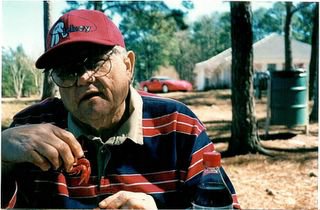The Tale of Brassie McIe
“Austere perseverance, harsh and continuous—rarely fails of its purpose, for its
silent power grows irresistibly greater with time.” –Wolfgang von Goethe
It was 1920—a time of “Roaring” plenty for some, but not for all. On what is now the site of a renowned golf course near Austin, Texas, local legend tells of Silas McIe, a poverty-stricken farmer who toiled his land to wring out meager crops of cotton and beans. With a gimpy mule, Silas plowed his acres endlessly, removing the prolific rocks and stones to make way for the blades of the harrow. It was ruthless and disappointing work. The more he dug, the more stones he dislodged. To add insult to his never-ending task, the rocks seemed to re-emerge overnight, and the infrequent dashing rains always revealed more.
The people of the nearby town of Manor thought Silas strange, living alone as he did in the clapboard shack on the edge of the usually dry creek. The house was a weather-forgiving place, its roof nothing more than heavy mesquite thatch and its windows long abandoned of panes. The only proof of life was his candlelight at night, and the always-present wisps of smoke that danced from a crooked chimney pipe.
Unshakable determination was a hallmark of the McIe mystique, and considerable money changed hands when farmers around Manor bet on the success or failure of his crops. Some years he fooled them all, bringing in 20 bales of cotton or more. Other years they saw no crop at all. But there was one thing that they could count on. Every Saturday would be another “Brassie McIe Day”—the nickname given to Silas by his observers.
After good daylight on Saturdays, a number of people from Manor always traveled to the McIe farm, parking their wagons as close to the gate as possible. Silas’crude-lettered sign, “No Trespassing-Even with Permission” blocked any intrusion beyond the gate. Some thought the words were humorous--others believed them ominous, even frightening. For years, the ladies of Manor said old Silas walked the grounds with a shotgun. But “Brassie Day” proved that the “weapon” was not a shotgun at all.
Brassie Day always stirred a festive picnic atmosphere. Town folk sat on wagon sideboards and wooden benches they brought to the site. Families brought covered lunches and the men stuffed extra pouches of their favorite tobacco into their overalls pockets. Folks settled in for a long day, and waited patiently for Brassie to emerge and his “oddity pastime” to begin.
As dependable as daybreak, Brassie always showed. He strode across the field, dressed in knickers and a crumpled cap, with a single golf-iron in his hand. With each swing of the club, a small stone would whiz away, often sounding like the whir of a locust as it sailed through the air. He never missed—one swing, one stone.
It would have been foolish to bet against his aim. The rocks always landed in the creek bed, precisely at the north edge, and all within a ten-foot circle. In time, given his accuracy, the pile of stones formed a mound as high as a man’s waist. It remains there today—a monument to the passionate perseverance of Brassie McIe.
The tale goes on to say that on Saturday August 24, 1929, spectators did not see Brassie at his usual time. After a two-hour wait, two men from town ventured beyond his gate and walked to the little house. After no answer at the door, they went inside. Brassie was there, sitting at a rough-hewn table, with his knickers and hat. His eyes were open but he did not see.
On the wall over the fireplace was a hand-rubbed mesquite plank with forks of deer antlers attached to each end. The antlers served as a kind of cradle for Brassie’s golf iron. The club was crudely made, fashioned from a heavy steel rod. Its grip was wrapped with deer hide worn slick by oily sweat. The clubface was hammered with dimples and grooved from countless encounters with stone.
Affixed to the plank was said to be an inscription, engraved on a shiny copper sheath. It read:
“Oh golf, thou hath stolen my soul.”
* * *
© Copyright 2005 by the author, Lad Moore


<< Home